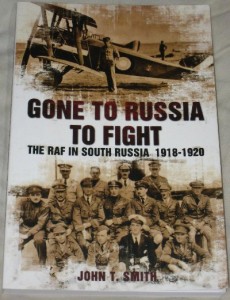The international intervention into the Russian Civil War — basically, the Western Entente (Allies) attempting to first keep Russia in the fight against Germany, and then to defeat the Bolsheviks and assist the anti-Bolshevik Whites — is not an area that gets a lot of attention, being overlooked as a sideshow both to the Great War and even to the larger Russian Civil War. Gone To Russia To Fight: The RAF in South Russia 1918-1920 is a look at a unique (and even more overlooked…) piece of that sideshow: the involvement of a couple of Royal Air Force squadrons in Southern Russia and the Caucasus/trans-Caucasus/Caspian Sea area during the Russian Civil War.
“Very little has been written about the RAF in south Russia and much of what has been written has been inaccurate. Several myths have been accepted as truths and written into the histories. This book is an attempt to set the record straight by going back, where possible, to the primary sources.”
— Introduction, Gone to Russia To Fight
The book opens with a couple of chapters giving a brief overview of the entire Russian Civil War, the background to sending the RAF and other forces into Russia, and the adventures of Dunsterforce around the Caspian early in the RCW, then goes through the entire RAF deployment one month per chapter. The author, John T. Smith, goes right back to squadron diaries and both published and unpublished memoirs for his material, in several cases pointing out where previous popular histories (or even published memoirs) clash with the squadron diary records and are likely or even provably incorrect.
One unexpected connection to local Canadian history I learned through this book: Raymond Collishaw, a fairly well known RAF WW1 ace who was born in the same region of Canada I live in, was one of the RAF officers in charge of the South Russia expedition. Our very own local connection to the events of this book — who knew?

The book has some neat period photographs from a variety of archives, including some fished out of the Russian archives in recent years. The writing is clear and readable, although Smith’s writing style, especially in the first few chapters, is staccato and choppy at times, with lots of short sentences, sometimes to the point where it seems like a grade-school textbook instead of an adult history book. The one major disappointment are the maps. There are only four in the whole book, none of which adequately cover the area discussed in the text. The detail map of one harbour on the Caspian repeatedly attacked by the RAF forces seems kind of pointless, given that a clear, full-page annotated aerial photograph is also included. Given the unfamiliarity of the theatre, the sometimes difficult Russian place names, and the fact that many place names have changed in the intervening 90-some years (making modern atlases or Google Maps unreliable), a few good detailed maps would have been a huge help.
The maps aside, this is an interesting and clearly written look at an oft-forgotten theatre, and Smith does a great job of going right back to primary documents to provide the clearest possible narrative of events 90+ years ago.
Gone to Russia To Fight: The RAF in South Russia 1918-1920 by John T. Smith, published 2010 by Amberley Press. £5.95 from Naval & Military Press. (normally £14.99, no idea how long the discount from NMP will last, but grab it while you can!)
The Shortest Possible Review: A fascinating look at an overlooked piece of RAF history, and a unique perspective on the Russian Civil War.
As a wargamer, I’m now fighting the urge to get some aircraft and some river boats and barges to try and recreate some of the actions from Gone to Russia. Maybe the 1/600 RCW ships from PT Dockyard and some 1/600 WW1 aircraft from Tumbling Dice or elsewhere? Must resist, not got the time or budget right now for a new scale!

Interesting book. I have been very interested in the Allied presence during the Russian Civil War.
It would be an interesting air campaign to be sure.